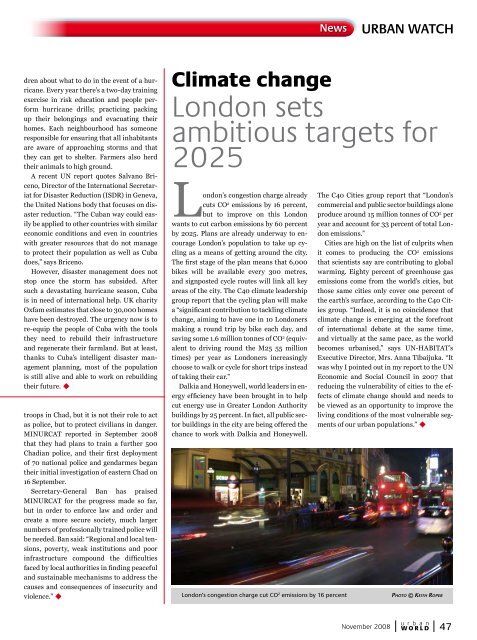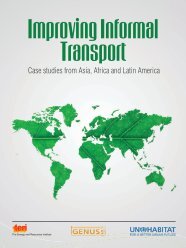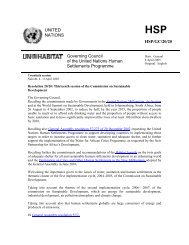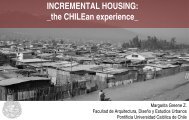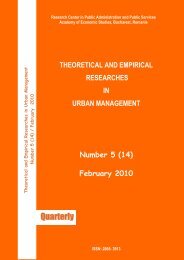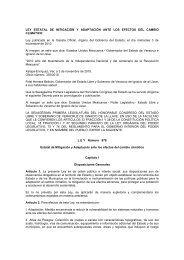Harmonious cities - UN-Habitat
Harmonious cities - UN-Habitat
Harmonious cities - UN-Habitat
You also want an ePaper? Increase the reach of your titles
YUMPU automatically turns print PDFs into web optimized ePapers that Google loves.
dren about what to do in the event of a hurricane.<br />
Every year there’s a two-day training<br />
exercise in risk education and people perform<br />
hurricane drills; practicing packing<br />
up their belongings and evacuating their<br />
homes. Each neighbourhood has someone<br />
responsible for ensuring that all inhabitants<br />
are aware of approaching storms and that<br />
they can get to shelter. Farmers also herd<br />
their animals to high ground.<br />
A recent <strong>UN</strong> report quotes Salvano Briceno,<br />
Director of the International Secretariat<br />
for Disaster Reduction (ISDR) in Geneva,<br />
the United Nations body that focuses on disaster<br />
reduction. “The Cuban way could easily<br />
be applied to other countries with similar<br />
economic conditions and even in countries<br />
with greater resources that do not manage<br />
to protect their population as well as Cuba<br />
does,” says Briceno.<br />
However, disaster management does not<br />
stop once the storm has subsided. After<br />
such a devastating hurricane season, Cuba<br />
is in need of international help. UK charity<br />
Oxfam estimates that close to 30,000 homes<br />
have been destroyed. The urgency now is to<br />
re-equip the people of Cuba with the tools<br />
they need to rebuild their infrastructure<br />
and regenerate their farmland. But at least,<br />
thanks to Cuba’s intelligent disaster management<br />
planning, most of the population<br />
is still alive and able to work on rebuilding<br />
their future. u<br />
troops in Chad, but it is not their role to act<br />
as police, but to protect civilians in danger.<br />
MINURCAT reported in September 2008<br />
that they had plans to train a further 500<br />
Chadian police, and their first deployment<br />
of 70 national police and gendarmes began<br />
their initial investigation of eastern Chad on<br />
16 September.<br />
Secretary-General Ban has praised<br />
MINURCAT for the progress made so far,<br />
but in order to enforce law and order and<br />
create a more secure society, much larger<br />
numbers of professionally trained police will<br />
be needed. Ban said: “Regional and local tensions,<br />
poverty, weak institutions and poor<br />
infrastructure compound the difficulties<br />
faced by local authorities in finding peaceful<br />
and sustainable mechanisms to address the<br />
causes and consequences of insecurity and<br />
London’s congestion charge already<br />
cuts CO 2 emissions by 16 percent,<br />
but to improve on this London<br />
wants to cut carbon emissions by 60 percent<br />
by 2025. Plans are already underway to encourage<br />
London’s population to take up cycling<br />
as a means of getting around the city.<br />
The first stage of the plan means that 6,000<br />
bikes will be available every 300 metres,<br />
and signposted cycle routes will link all key<br />
areas of the city. The C40 climate leadership<br />
group report that the cycling plan will make<br />
a “significant contribution to tackling climate<br />
change, aiming to have one in 10 Londoners<br />
making a round trip by bike each day, and<br />
saving some 1.6 million tonnes of CO 2 (equivalent<br />
to driving round the M25 55 million<br />
times) per year as Londoners increasingly<br />
choose to walk or cycle for short trips instead<br />
of taking their car.”<br />
Dalkia and Honeywell, world leaders in energy<br />
efficiency have been brought in to help<br />
cut energy use in Greater London Authority<br />
buildings by 25 percent. In fact, all public sector<br />
buildings in the city are being offered the<br />
chance to work with Dalkia and Honeywell.<br />
News<br />
URBAN WATCH<br />
Climate change<br />
London sets<br />
ambitious targets for<br />
2025<br />
The C40 Cities group report that “London’s<br />
commercial and public sector buildings alone<br />
produce around 15 million tonnes of CO 2 per<br />
year and account for 33 percent of total London<br />
emissions.”<br />
Cities are high on the list of culprits when<br />
it comes to producing the CO 2 emissions<br />
that scientists say are contributing to global<br />
warming. Eighty percent of greenhouse gas<br />
emissions come from the world’s <strong>cities</strong>, but<br />
those same <strong>cities</strong> only cover one percent of<br />
the earth’s surface, according to the C40 Cities<br />
group. “Indeed, it is no coincidence that<br />
climate change is emerging at the forefront<br />
of international debate at the same time,<br />
and virtually at the same pace, as the world<br />
becomes urbanised,” says <strong>UN</strong>-HABITAT’s<br />
Executive Director, Mrs. Anna Tibaijuka. “It<br />
was why I pointed out in my report to the <strong>UN</strong><br />
Economic and Social Council in 2007 that<br />
reducing the vulnerability of <strong>cities</strong> to the effects<br />
of climate change should and needs to<br />
be viewed as an opportunity to improve the<br />
living conditions of the most vulnerable segments<br />
of our urban populations.” u<br />
violence.” u London’s congestion charge cut CO 2 emissions by 16 percent Ph o t o © kei t h ro P er<br />
u r b a n<br />
November 2008 WORLD 47


